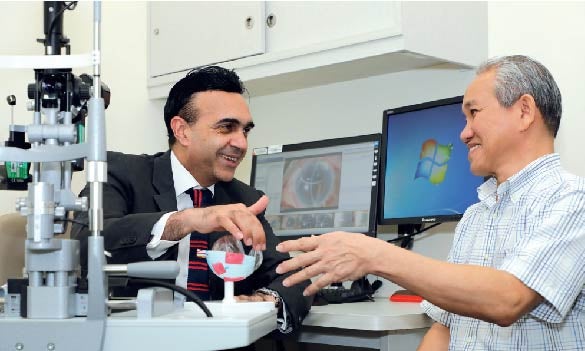
Established in 1991, the Singapore Eye Bank (SEB) at the Singapore National Eye Centre (SNEC) is committed to its national remit of procuring, processing and distributing corneal tissue of the highest quality for corneal transplants performed in Singapore. SEB has since supported over 7,500 corneal transplants.
THE HOSPITAL EYE DONATION PROGRAMME (HDEP)
While quality corneal tissue can be imported from eye banks in the United States to meet the volume of transplants performed in Singapore, supply and importation could be adversely affected by unforeseen circumstances such as the COVID-19 pandemic, and prices could be prohibitively expensive.
It is therefore critical that SEB continues to focus its efforts on its successful Hospital Eye Donation Programme (HEDP), a collaborative effort between SEB and its network of affiliated hospitals devoted to increasing local cornea output.
There are currently four HEDP-affiliated hospitals across the island: Singapore General Hospital, Tan Tock Seng Hospital, Changi General Hospital and National University Hospital. They are covered by four Eye Donation Counsellors working extended hours to provide grief counselling to the bereaved next-of-kin of potential hospital donors, advocate the meritorious gift of sight and obtain consent for corneal donation.
Working closely as a team, SEB’s four Tissue Coordinators provide 24/7 on-call coverage on rotation, attending to cornea recovery materialising from HEDP as well as multi-organ recoveries nationwide under the Human Organ Transplant Act.
Corneas procured through HEDP continue to serve as a major source of local donor corneas for Singaporeans and Permanent Residents in need of transplants.
In 2019, SEB has also begun counselling and conducting cornea recovery at hospices and homes, as local post-discharge care programmes become more comprehensive and readily available, and chronically ill patients are discharged from acute hospitals to hospices or homes for continuous care.
What happens when a cornea becomes available
THE HEDP WORKFLOW
|
How we increase awareness through outreach
1. Talks and Updates
By providing regular eye donation awareness talks and educational updates on advances in corneal surgery to medical and nursing staff as well as allied health professionals at HEDP-affiliated hospitals, SEB’s team of Eye Donation Counsellors continues to engage its HEDP colleagues in its quest to increase local cornea donation.
2. Donor Outreach
Every year, a calendar of donor outreach activities is also organised to increase public awareness to primarily dispel social impediments regarding corneal donation, and provide information on the legislation and process of eye donation with the objective of instilling a pro-eyedonation spirit in the local community.
SUPPORTING EYE SURGERIES AND PROCEDURES
As corneal surgery increases in complexity, SEB’s team of Tissue Coordinators is rigorously trained to perform tissue processing for lamellar corneal surgery.
SEB’s donor pre-cutting service commenced in late 2011 to serve an increasing number of surgeons performing descemet stripping automated endothelial keratoplasty (DSAEK). Precutting for DSAEK is carried out ahead of scheduled surgery in SEB’s facility to shorten surgical time, and at the same time allow for additional quality assurance measures to be performed, thereby increasing patient safety and optimising surgical outcomes.
From April 2019, SEB has rolled out its pre-stripped cornea service to support corneal surgeons’ progressive switch to a more complex descemet membrane endothelial keratoplasty (DMEK) surgery –which provides patients with better visual acuity, lower rejection of donor tissue and more rapid visual rehabilitation. SEB is one of the first eye banks in Asia to provide this pre-stripped cornea service.
TRAINING AND RESEARCH
SEB plays a pivotal role in the training and education of medical, nursing, and allied health professional staff through the organisation of lectures, courses and seminars. In addition to organising the SEB biannual Cornea Procurement Accreditation course, a curriculum essential to all incoming ophthalmology residents, SEB also provides logistical and manpower support to SNEC’s ALK/DSAEK/DMEK Advanced Cornea course which runs at least once a year.
SEB also participates actively in conducting and supporting research projects in the field of cornea.













 Get it on Google Play
Get it on Google Play